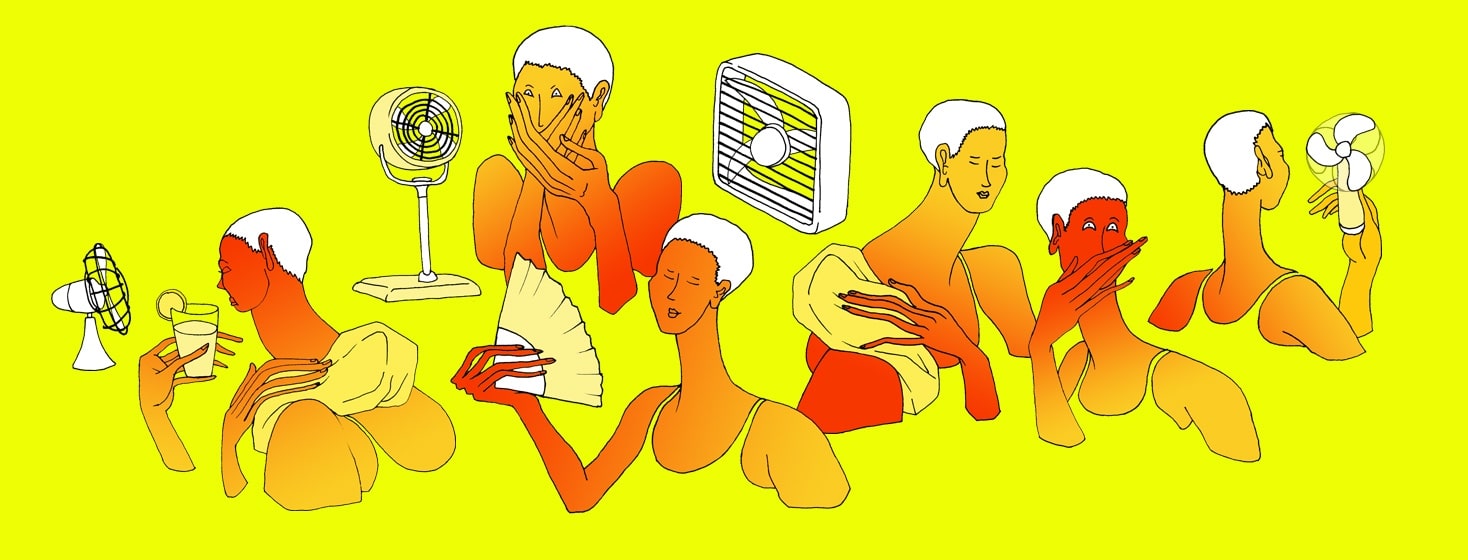Hot Tips for Handling Hot Flashes
For those dealing with the various symptoms of menopause - whether surgery-related, chemotherapy-induced, or brought on by certain types of prescription medications - hot flashes and night sweats are likely an all-too-familiar side effect. This may be especially true for cancer patients who have been prescribed aromatase inhibitors, which work to prohibit estrogen production and prevent the chance of recurrence for hormone-dominant gynecological cancers.
Just as the name sounds, a hot flash (or “hot flush”) can feel like a sudden, all-consuming flare-up of heat, paired with sweating and red, flushed skin. This intense heat typically originates in the torso, including the chest, arms, neck, and face—and can last anywhere from 30 seconds to upwards of 10 minutes.
For many ovarian cancer patients, this extremely common menopausal symptom may seem unavoidable, and can often negatively impact one’s quality of life. Here are some tips to help make hot flashes somewhat more tolerable.
Portable fans
Battery-operated and/or rechargeable hand-held fans, as well as retracting cockade fans, can be total lifesavers during a hot flash. These are often slim enough to fit in most purses and handbags, so you can bring them along with you anywhere you go. I find these to be particularly helpful at summer concerts and other outdoor events.
Certain fan models are sold with an optional lanyard, so you can wear it around your neck for easier access. Portable neck fans that wrap around your neck (similarly to a travel neck pillow) are also a convenient, innovative option that looks like a modern pair of headphones, and help quickly cool down your body temperature.
Sleeping with a bedside fan is also highly recommended for those suffering from intense and/or frequent night sweats.
Essential oils
Essential oil blends that use scents like peppermint, eucalyptus, lemongrass, orange, basil, sage, lavender, and tea tree oil, are all great options for alleviating the intensity and/or frequency of hot flashes. Oil essences are often inhaled (either directly or via an oil diffuser/humidifier), for aromatherapy benefits. Most essential oil products are sold in droppers, tinctures, rollers, mists, and sprays, that are ready for immediate application.
However, it’s important to keep in mind that pure, undiluted (or “neat”) essential oils should never be ingested or applied directly to the skin, as they can sometimes cause harmful irritation and burning. Ensure essential oils are always diluted with a carrier oil like coconut, jojoba, or olive oil. It’s also recommended to conduct a patch test before doing a full application to avoid any negative allergic reactions.
Ice packs and ice rollers
Whenever you’re at home, or when you have access to a refrigerator or even an ice chest/cooler, ice packs and ice rollers can provide super-fast relief whenever a hot flash arises. Ice rollers are typically used as beauty tools to prevent and treat wrinkles, so they are also great solutions for several other ailments including headaches, inflamed skin, and muscle aches--whether menopause-related or not.
Simply store in the freezer at all times, so you can have it ready to use as needed. Gently roll on your face, neck, and chest for instant cooling relief. Otherwise, an ice pack or even a bag of frozen veggies are easy, tried-and-true alternatives that are guaranteed to do the trick.
Avoid spicy foods, caffeine, and alcohol
There are a variety of triggers for hot flashes, but many agree that consuming spicy foods, caffeine, and alcohol are all common causes.
With regard to alcohol intake and spicy food consumption, the body’s heart rate will speed up, causing the skin’s blood vessels to dilate. As a result, this process leads one’s skin to feel warm and flushed. Hot peppers, jalapenos, and chili powders like cayenne pepper, as well as red wine, are all recognized vasodilators (as they are considered to be some of the most common causes of hot flashes). Similarly, hot foods like soups and stews can also provoke a hot flash.
When drinking alcoholic beverages, it’s best to stay as hydrated as possible. The more water in your body, the more efficiently your body can digest the alcohol.
On the other hand, caffeine actually narrows blood vessels, as opposed to widening them. Regardless, consuming coffee, tea, and other caffeinated drinks can still have the same heating effect as it can raise one’s heart rate, and thus increase the rate at which blood flows through the body.
Dress in layers
Dressing in layers that can easily be removed is advantageous so you can always adjust your clothing based on how you’re feeling at that particular moment. No matter the season or weather, whenever your body temperature starts to climb, you can simply remove a layer or two as needed to help cool yourself down.
It’s usually best to wear lightweight, looser-fitting clothes made with natural fibers, such as cotton, rayon, or linen) which are more breathable. These fabrics often dry relatively quickly and help release heat. Moisture-wicking fabrics (synthetic fabrics like polyester and nylon) can also draw dampness away from the body.
Hormone Replacement Therapy (HRT)
Many health professionals may recommend hormone-replacement therapy (HRT) to help alleviate menopausal symptoms, but it is important to keep in mind that these are not intended for all ovarian cancer patients - especially those with estrogen-responsive cancers.
Make sure to ask your doctor before starting any new medications or remedies, including natural products and supplements. Your physician can help you make decisions and evaluate which options are best for you.

Join the conversation